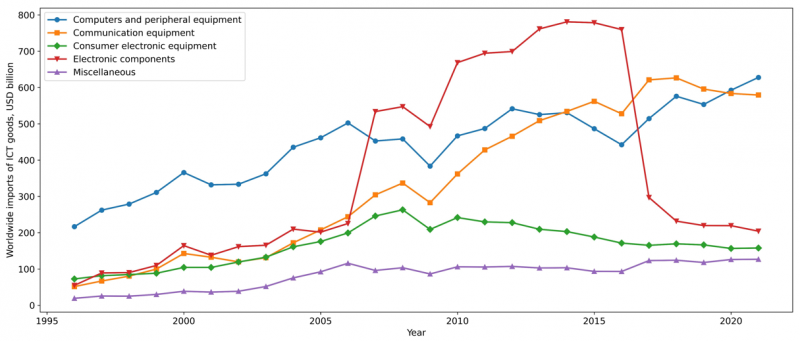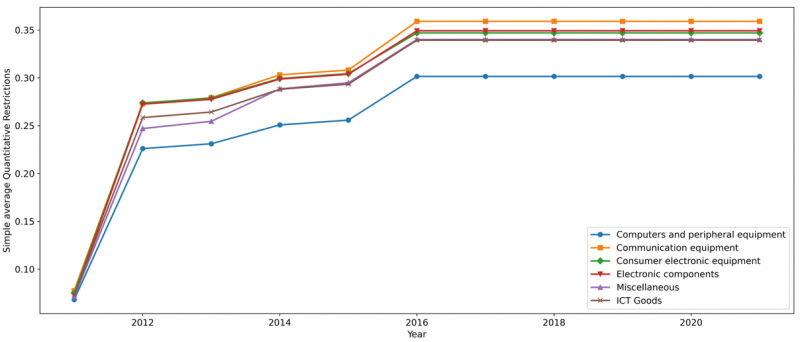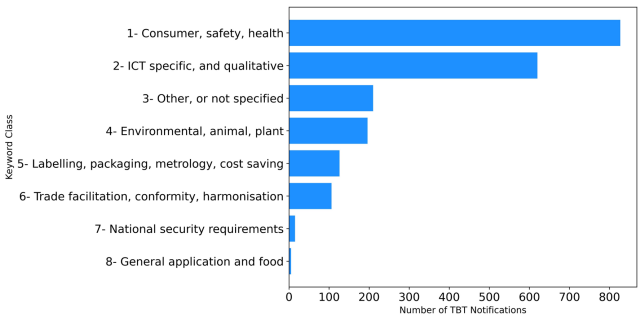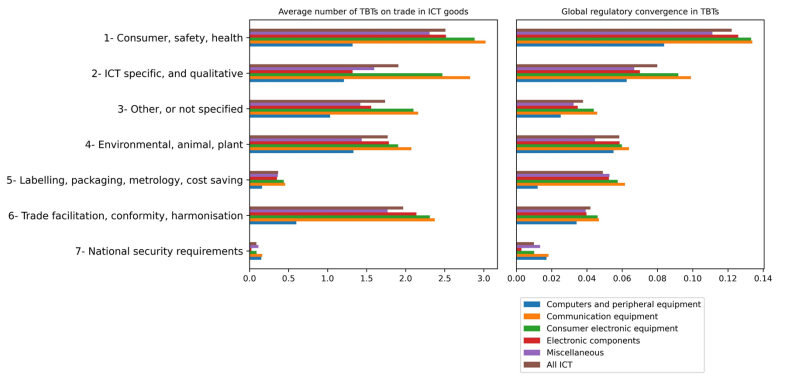

This study examines the impact of regulatory convergence on global information and communications technology (ICT) imports from 1996 to 2019. We analyse how convergence in specific regulatory objectives, as indicated by keywords in notified technical barriers to trade (TBTs) at the World Trade Organization (WTO), influences import values, volumes, and prices. Our findings suggest that regulatory convergence between trading partners in certain TBT categories related to consumer, safety, health, and ICT-specific regulations boosts import values and lowers import prices. However, the effects vary across different categories of ICT goods. These insights are pertinent for policymakers aiming to enhance trade in the ICT sector.
In the past two decades, non-tariff measures (NTMs) have emerged as key instruments in trade policy. With the inception of the General Agreement on Tariffs and Trade (GATT) in 1947 and the subsequent establishment of the WTO in 1995, countries have sought to streamline trade in goods through tariff reductions and other non-tariff barriers (NTBs). Regulatory oversight became essential, especially for goods posing safety, environmental, or health risks.
TBTs, as regulatory NTMs, aim to protect consumers from unsafe or substandard products. They cover a broad spectrum of objectives, from safety measures to national security considerations. Compliance with TBTs can influence trade costs, thereby affecting the prices, volumes, and values of imported goods. However, the effect of TBTs on trade can be facilitative or restrictive, contingent on the alignment between the standards of exporting firms and the requirements of destination markets.
While some studies have focused on regulatory divergence in trade (Piermartini and Budetta, 2009; Cadot et al., 2015; Cadot and Ing, 2015; Knebel and Peters, 2019; Nabeshima and Obashi, 2021; Inui et al., 2021), none has delved into convergence. Comprehensive trade agreements not only aim to reduce tariffs but also to harmonize and mutually recognize regulations between countries. Such harmonization is more straightforward when countries share similar trade policies, potentially reducing compliance costs. However, existing research doesn’t fully elucidate how convergence in various regulatory NTMs affects trade.
A recent paper by Ghodsi (2023) fills this gap by examining the influence of regulatory convergence within TBTs on ICT goods imports from 1996 to 2019. Using a gravity model of global bilateral trade, it evaluates the impact of shared TBT objectives, identified through keywords in WTO notifications of unilateral TBTs, on trade values, volumes, and unit prices. This analysis also considers other bilateral quantitative NTBs, such as antidumping and countervailing duties, quantitative restrictions, and traditional tariffs.
Different TBT objectives can have varied effects on products based on their functionality. For instance, TBTs aimed at ensuring consumer safety or providing labelling and packaging information typically affect consumer goods more than capital or intermediate products. Intermediate goods, used across various production stages, often need to meet specific specifications. Thus, regulatory convergence in TBTs with detailed standards can significantly influence trade in these products. TBT objectives that promote trade facilitation by addressing conformity assessments, compliance, or harmonization can impact trade in all goods types. Such trade-enhancing TBTs might reduce trade costs and increase trade volumes without significantly changing traded values. To understand how convergence in different TBT objectives affects goods based on their functionality, this paper analyses distinct categories of ICT goods, considering their unique characteristics.
The COVID-19 pandemic and extensive lockdowns in numerous countries have underscored the pivotal role played by ICT goods. Businesses increasingly relied on home offices and telecommuting, which were made possible by digitalization. Notably, between 2019 and 2021, there was a remarkable 13.5% surge in imports of ICT goods, specifically in the computer and peripheral equipment category, reaching a substantial USD 628 billion by 2021 as depicted in Figure 1. This vividly highlights the significance of ICT goods, particularly in enabling remote work during the pandemic.
However, it’s worth noting that during the same period, the import values of ICT goods in other categories experienced a decline due to the global economic slowdown and border closures. Starting in 2007, electronic components emerged as the dominant category in the trade of ICT goods, reaching a peak value of USD 800 billion in 2014, accounting for 5% of the global import value of all goods. This shift was primarily driven by the increasing importance of these intricate components as intermediate inputs in various industries. Today, semiconductors and electronic chips find applications in a wide range of products, from simple light bulbs to more complex items such as electronic devices, ICT goods, machinery, and automobiles.
Figure 1: Worldwide Imports of ICT Goods by Product Category (1996-2019)

Source: Ghodsi (2023).
The recent hype surrounding Artificial Intelligence (AI) in the turbulent capital markets of major semiconductor producers, including Nvidia Inc., Intel Corporation, Advanced Micro Devices, Inc., Qualcomm Semiconductor Company, Broadcom Inc., and Taiwan Semiconductor Manufacturing Company Limited, underscores the importance of this sector. However, the substantial decline in the trade value of these vital goods post-2016 can be attributed to increased production capacities in various countries to meet domestic demands. Moreover, it’s noteworthy that this decline could be linked to the impact of heightened tariffs during Donald Trump’s presidency in the United States and the proliferation of NTBs, such as antidumping, quantitative restrictions, and countervailing duties.
For instance, econometric results reveal that a one-percent increase in tariffs imposed on semiconductor trade leads to a 3.9% reduction in their trade values, while a one-percent increase in the number of quantitative restrictions results in a trade value reduction of approximately 3.2%. The marginal effects of quantitative restrictions on import volumes of these important goods are even larger, exceeding 4.5%. As Figure 2 illustrates, the average number of quantitative restrictions on all bilateral global tariff lines for electronic components increased by 15% in 2016 to 0.35 quantitative restrictions per tariff line. This had a substantial impact on the reduction of trade values for these goods. Nonetheless, regulatory convergence within TBTs with three primary objectives—addressing environmental issues, ensuring consumer safety, and safeguarding national security—has had a positive influence on trade in these critical goods.
Figure 2: Simple average Quantitative Restrictions in force on ICT goods, by category, 2011-2021

Source: Ghodsi (2023).
Figure 3: TBT notifications (based on keyword classification) in force in 2019 on ICT goods

Source: Ghodsi (2023).
Between 1996 and 2019, the WTO received 1,456 notifications of TBTs affecting ICT goods, categorized into 30 different regulatory objectives based on keywords. The most frequent TBT objectives were related to ‘consumer, safety, and health’, with 827 TBT notifications, followed by ‘ICT specific and qualitative’ objectives with 620 notifications as shown in Figure 3. ‘Environmental, animal, plant’ objectives accounted for 196 TBT notifications, primarily focused on addressing environmental concerns associated with harmful ICT goods. However, TBTs with general applications or ‘national security requirements’ were less commonly used for ICT goods trade.
Notably, these TBTs can target multiple products for cross-border regulation, and the degree of heterogeneity among TBTs is often overlooked. The left panel of Figure 4 displays the average number of TBTs for ICT products based on keywords’ objectives. Once again, TBTs with ‘consumer safety and health’ objectives are targeting the largest number of tariff lines. ‘Trade facilitation, conformity, and harmonization’ keywords appeared in 106 TBT notifications, ranking second in terms of objectives targeting products, with an average of 1.98 notifications per product. This diversity highlights the understudied TBT heterogeneity.
Figure 4: Regulatory convergence in TBTs across trading partners in 2019

Source: Ghodsi (2023).
The right panel of Figure 4 illustrates the regulatory convergence in TBTs on ICT goods in 2019. It shows the percentage of bilateral tariff lines where both trading partners imposed TBTs with the same objectives, with ‘consumer, safety and health’ ranking highest. For example, ‘communication equipment’ and ‘consumer electronic equipment’ had TBTs related to ‘consumer health and safety’ enforced by both trading partners on 13.5% and 13.4% of their tariff lines, respectively. Overall, regulatory convergence was more prominent between developed economies, especially in objectives related to ‘consumer safety, health,’ and ‘environmental’ concerns. Developing economies had fewer similarities in TBT objectives, highlighting differences in regulatory priorities.
Import values: The gravity estimation results for bilateral ICT goods imports from 1996 to 2019 (excluding intra-EU trade) reveal significant findings. Among TBT categories, regulatory convergence positively impacts import values in ‘consumer, safety, health,’ ‘ICT specific, and qualitative,’ and ‘environmental, animal, plant’ categories. For example, when both countries impose TBTs targeting environmental issues, bilateral imports increase by around 13%. The most substantial impact is observed in the ‘consumer, safety, health’ category with a trade elasticity of 13.88%. However, the positive impact diminishes when PTAs with TBT provisions are enacted, possibly because similarities in TBTs existed prior to PTAs. Notably, the PTA variable is statistically insignificant in all models. Conversely, ‘trade facilitation, conformity, and harmonization’ objectives show a negative impact on import values, albeit statistically significant only at the 10% level.
Tariffs have a notable negative impact on import values, as a 1% reduction results in a 0.35% increase in import values. Countervailing duties, although applied to a limited number of tariff lines, effectively reduce imports. Antidumping and quantitative restrictions also decrease import values but lack statistical significance in models including all ICT goods. The variation in quantitative NTBs’ effects is particularly evident across ICT product categories, with a significant adverse effect observed in electronic equipment trade.
Import volumes: The estimation results also indicate that regulatory convergence in TBTs does not significantly impact import volumes, even with PTAs. However, PTAs alone stimulate ICT goods trade, increasing volumes by at least 6%. Tariffs exhibit a near-unity elasticity, reducing imports by about 1% per 1% tariff increase. For countervailing duties, the elasticity exceeds unity, with a 1% increase resulting in a 1.13% import volume reduction, also statistically significant at 1%.
Import prices: Statistically significant correlations are found between TBT convergence and lower import prices in the ‘consumer, safety, health,’ ‘ICT specific, and qualitative,’ and ‘national security requirements’ categories. Conversely, convergence in ‘labeling, packaging, metrology, cost-saving’ TBTs is associated with higher prices. These coefficients can be interpreted as ad-valorem equivalence, akin to Cadot and Gourdon (2016). Therefore, a requirement for additional labeling would induce the ad-valorem costs. For instance, additional ink on each package would be the cost that is shown in the positive elasticity. For PTAs with TBT provisions, convergence in ‘ICT specific, and qualitative,’ ‘environmental, animal, plant,’ and ‘national security requirements’ objectives have positive and statistically significant coefficients on import prices. Some PTAs without ‘consumer, safety, health,’ and ‘national security requirement’ convergence increase import prices significantly. Tariffs notably reduce import prices, with a 1% tariff increase leading to a 13% decrease in import prices, while antidumping slightly lowers prices by about 8%. Countervailing duties and quantitative restrictions do not significantly affect import prices.
Efforts to liberalize global trade have led to reduced tariffs but have seen the rise of non-tariff measures (NTMs), including regulatory ones like technical barriers to trade (TBTs). TBTs can create compliance costs for exporters, yet when both trading partners enact similar TBTs, trade should remain unaffected or even benefit. However, TBTs vary in objectives and functionality. This analysis covers the impact of regulatory convergence on global bilateral import values, volumes, and prices of ICT goods from 1996 to 2019.
TBTs, unlike tariffs and quantitative NTMs, are unilateral and non-discriminatory, making them challenging to analyse in a gravity model that includes multilateral resistances. To analyse them in a gravity model, regulatory convergence is measured based on keywords cited in TBT notifications to the WTO. The study focuses on TBT objectives, aiming to provide insights for policymakers who implement NTMs for specific goals. Results show heterogeneity in the impact of regulatory convergence across TBT classes, product categories, and country groups. Some convergence stimulates import values, but it’s less influential on import volumes due to heterogeneity among ICT goods. Convergence in different objectives also affects the price of global ICT imports differently.
Tariffs and countervailing duties significantly reduce the value and volume of ICT imports. Deepening preferential trade agreements (PTAs) boosts import volumes, while tariffs and quantitative NTMs remain barriers. Tariffs and quantitative NTMs have hampered imports of ICT goods, particularly electronic components, despite liberalization efforts in earlier decades. To facilitate trade in ICT goods, countries should harmonize regulatory measures focusing on global objectives like consumer safety, environmental protection, and quality standards. Bilateral enforcement of PTAs with TBT provisions can offset negative impacts and stimulate trade values, suggesting the potential for trade promotion through regulatory convergence in TBT objectives.
Cadot, O., & Ing, L. Y. (2015). Non-tariff measures and harmonisation: Issues for the RCEP. ERIA Discussion Paper Series, 2015-61.
Cadot, O., Asprilla, A., Gourdon, J., Knebel, C., & Peters, R. (2015). Deep regional integration and non-tariff measures: A methodology for data analysis. UN Policy Issues in International Trade and Commodities Research Study Series No. 69.
Ghodsi, M., (2023). Regulatory convergence within technical barriers to trade, The World Economy, 2023, forthcoming
Inui, T., Ikeuchi, K., Obashi, A., & Yang, Q. (2021). The impact of regulatory distance from global standards on a country’s centrality in global value chains. International Economics, 166, 95-115.
Knebel, C., & Peters, R. (2019). Non-tariff measures and the impact of regulatory convergence in ASEAN. In: Lili Yan Ing, Olivier Cadot, & Ralf Peters (Eds.), Non-Tariff Measures in ASEAN. Jakarta: Economic Research Institute for ASEAN and East Asia.
Nabeshima, K., & Obashi, A. (2021). Impact of regulatory burdens on international trade. Journal of the Japanese and International Economies, 59, 101120.
Piermartini, R., & Budetta, M. (2009). A mapping of regional rules on technical barriers to trade. In: A. Estevadeordal, K. Suominen, & R. Teh (Eds.), Regional Rules in the Global Trading System (pp. 250-315. Cambridge: Cambridge University Press.